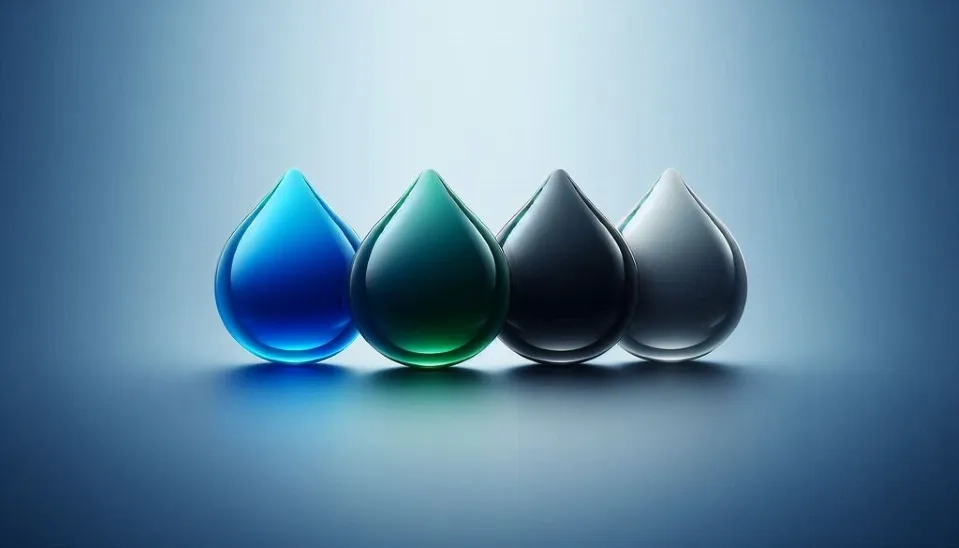
Lack of access to safe and sufficient water kills more than 1.2 million people yearly. According to the IHME report in 2019, death due to unsafe water sources ranked 13th among the main causes and risk factors for death and disease. Meanwhile, due to the development process and climate change, this statistic has the potential to increase and can affect more regions in the world in the future (Harikrishnan et al., 2018).
The lack of freshwater resources to meet human needs has caused agricultural and industrial development to be unsustainable and the use of non-renewable groundwater sources to surge. In the past two decades, attention to solutions such as increasing farm efficiency and preserving water resources, using unconventional water, and recycling water and wastewater techniques to supply the required water has been noticed by experts. To better understand these methods, one must first learn some key concepts in this field. In this article, we will examine different types of water color which includes green water, or the amount of water in the soil that can be accessed by plants, and water from domestic wastewater, which is classified as grey water or black water, depending on the level of contamination. Unlike blue water or surface and subsurface renewable resources, green, grey, and black water have received less attention. At the same time, knowing and understanding their importance makes it possible to minimize the consumption of blue water and contribute to a healthy and sustainable environment.
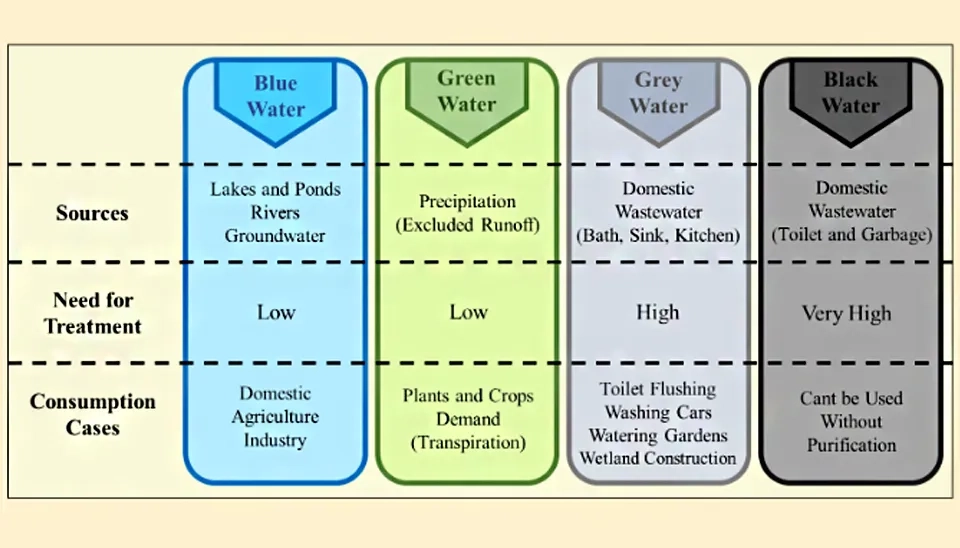
1. Blue Water
The renewable water found in surface water bodies such as rivers, lakes, ponds, and groundwater reservoirs is called blue water (Wang-Erlandsson et al., 2022). Blue water is recharged by different kinds of precipitation like rainfall or snowfall. Since groundwater withdrawal is more than its recharge rate, it is necessary to emphasize that blue water includes only the renewable part of the groundwater. Blue water is valuable for agriculture, industry, and municipalities because of its high quality and ease of use. Every year, large amounts of water from precipitation evaporate behind the dam lakes and become unavailable, or by turning into floods and entering urban stormwater collection systems, they will require treatment and purification processes for future consumption. The blue color of the water is the natural color which means the water has high quality and no serious pollutants.
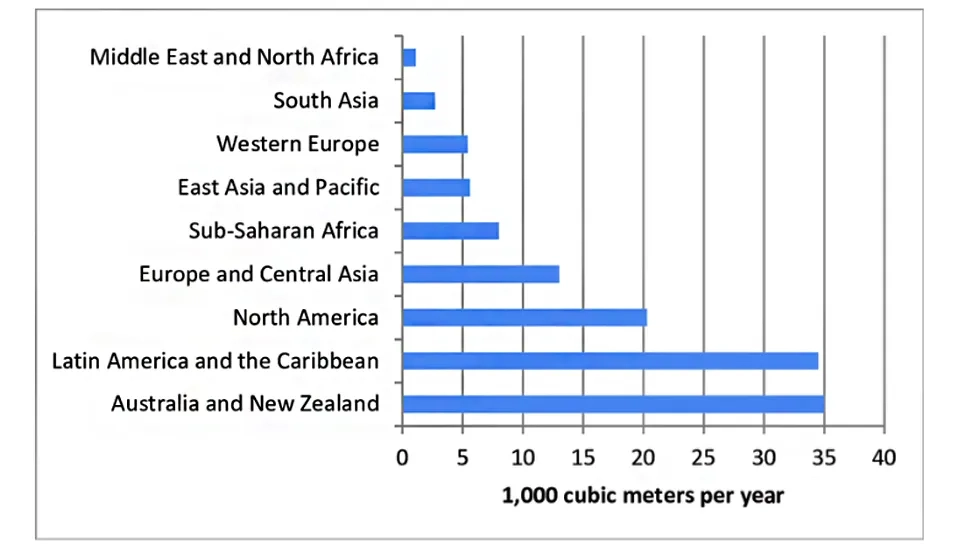
2. Green Water
Green is another color of water that implies a part of the precipitation that has occurred on the terrestrial part of the earth and is stored by the soil and then used to meet the water demands of plants and finally released to the atmosphere by evaporation and transpiration is called green water (Hordofa et al., 2023). If this water joins the subsurface streams or joins the groundwater by deep percolation and is no longer accessible by the plant roots, then the term “green water” does not belong to it anymore, and it is considered blue water. So the green color has been chosen because this type of water is related to plants and crops, which are naturally green.
With more penetration of rainfall through the soil surface and prevention of runoff, the amount of water in the soil (green water), as well as the water that recharges the groundwater (blue water), increases, which, according to the concepts of water balance in a watershed, ultimately leads to a boost in the local water budget and also prevention of flood and soil erosion. Factors such as vegetation, cover crops that shade the soil surface, sufficient organic matter, abundant macropores due to high biodiversity, and a healthy soil structure lead to Higher water-holding capacity and infiltration capacity. Also, increasing the availability of green water follows a reduction in the need for irrigation water, which is mainly supplied by blue water, and getting more crops per drop (Keesstra et al., 2021).
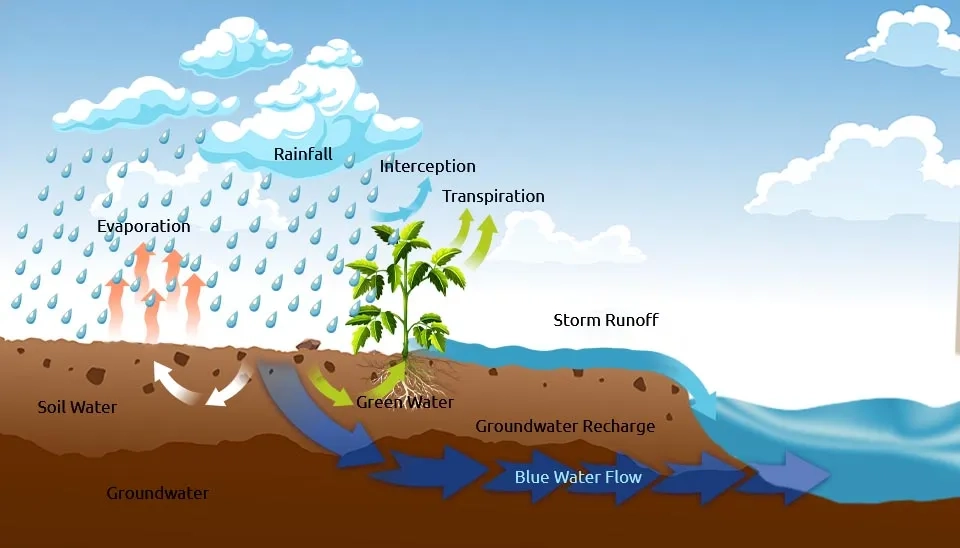
3. Greywater
The term greywater refers to domestic wastewater, which includes wastewater from washing machines, bathtubs and showers, laundry, hand-washing basins, sinks, and kitchen sewage. Greywater contributes a substantial percentage of domestic wastewater, about 50 to 80 percent. Choosing the grey color for water indicates that the grey water quality is less than blue water.
Table 1. Greywater sources and their composition (Elhegazy and Eid, 2020)
Greywater source | Constituents |
Bathroom | Shampoo, soap, toothpaste lint, traces of urine, body care products, hairs, skin, hair oil, body fats, hot water, and sand/clay particles |
Hand basin | toothpaste, soaps, body care products, shaving waste, hair, and skin cells |
Kitchen | Dishwashing detergents, oil, and fats, food residue, hot water, raw meat washing, fruit and vegetable peels, tea or coffee, traces of food preservatives, sand, and clay particles |
Laundry | Chemicals from detergents, oils, solvents, bleaches, paints, hot water, nonbiodegradable fibers from clothing |
The quality of greywater depends on several factors, such as lifestyle, initial water quality, population structure, and climatic conditions; it can contain a wide range of amounts of microbial pollutants and heavy metals. Therefore, its reuse without purification brings environmental and sanitary risks. However, after undergoing simple treatment processes, greywater can be suitable for various purposes, including washing cars, flushing toilets, constructing wetlands, watering gardens, and even agricultural irrigation, highlighting its strategic importance, particularly in areas experiencing water stress. As a result, the reuse and recycling of graywater can significantly contribute to saving water resources, minimising consumption for agricultural irrigation, reducing wastewater production, and decreasing energy and carbon footprints (Filali et al., 2022).
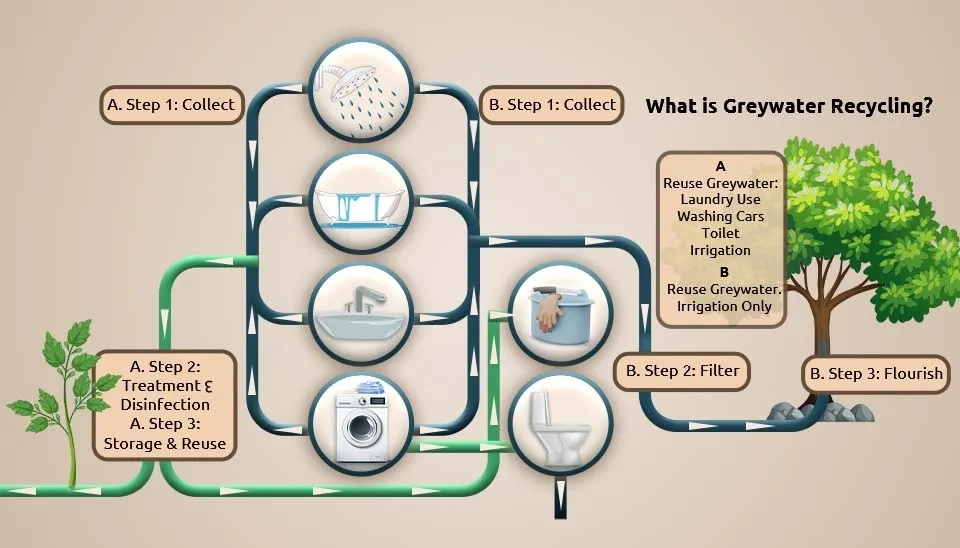
4. Black Water
Domestic wastewater can be classified into greywater and blackwater, which have differences in contamination levels. Blackwater includes toilet waste (fecal matter and urine) and food waste derived from garbage grinders. Since the concentration of pollutants and organic matter is higher in blackwater, it requires different treatment processes than greywater. Still, after purification, it can be used for cleaning and irrigation (Al-Husseini et al., 2021; Oarga-Mulec et al., 2023). The black color is darker than the grey color which indicates the quality of black water is lower than that of grey water. Releasing untreated blackwater can cause water and soil pollution. Therefore, It is essential to utilize advanced and cost-effective technologies in this field. Some high-efficiency technologies for blackwater treatment are anaerobic, membrane, and multifunctional microbial electrochemical treatments. Also, blackwater is suitable for resource recovery because significant amounts of N, P, and K are found in it. However, the methods of using black water for resource recovery have not stabilized and are unreliable. Therefore, this topic may be a contentious issue for researchers, experts, and industry leaders (Xu et al., 2023).
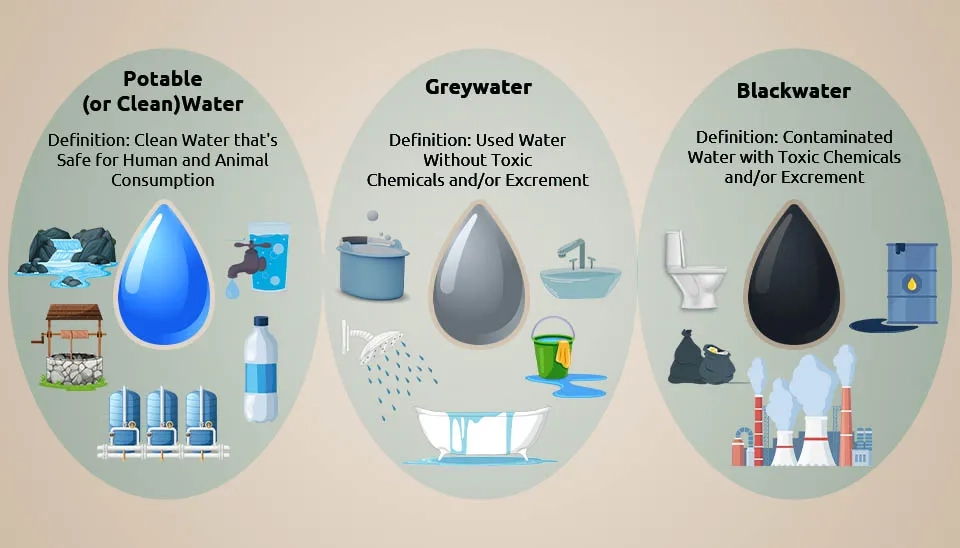
5. Conclusion
Considering the alarming condition of surface and groundwater resources, as well as the increase in population and the speed of development, it becomes necessary to save freshwater resources at the level of a region. One of the effective ways to achieve this goal is to prevent runoff and use rainfall to recharge groundwater Flooding causes the loss of valuable resources, which include soil moisture and green water. Also, in areas that face a lack of rainfall, recycling and treating domestic wastewater (greywater and blackwater) can be used as an efficient solution in providing the water needed for irrigation and cleaning. Different colors of water show different levels of contamination. Therefore, discussion and research about wastewater treatment methods should be given more attention by specialists and water resources managers, as well as investment to achieve low-cost and high-efficiency technologies.